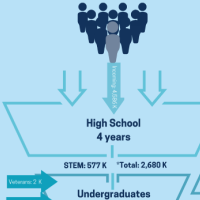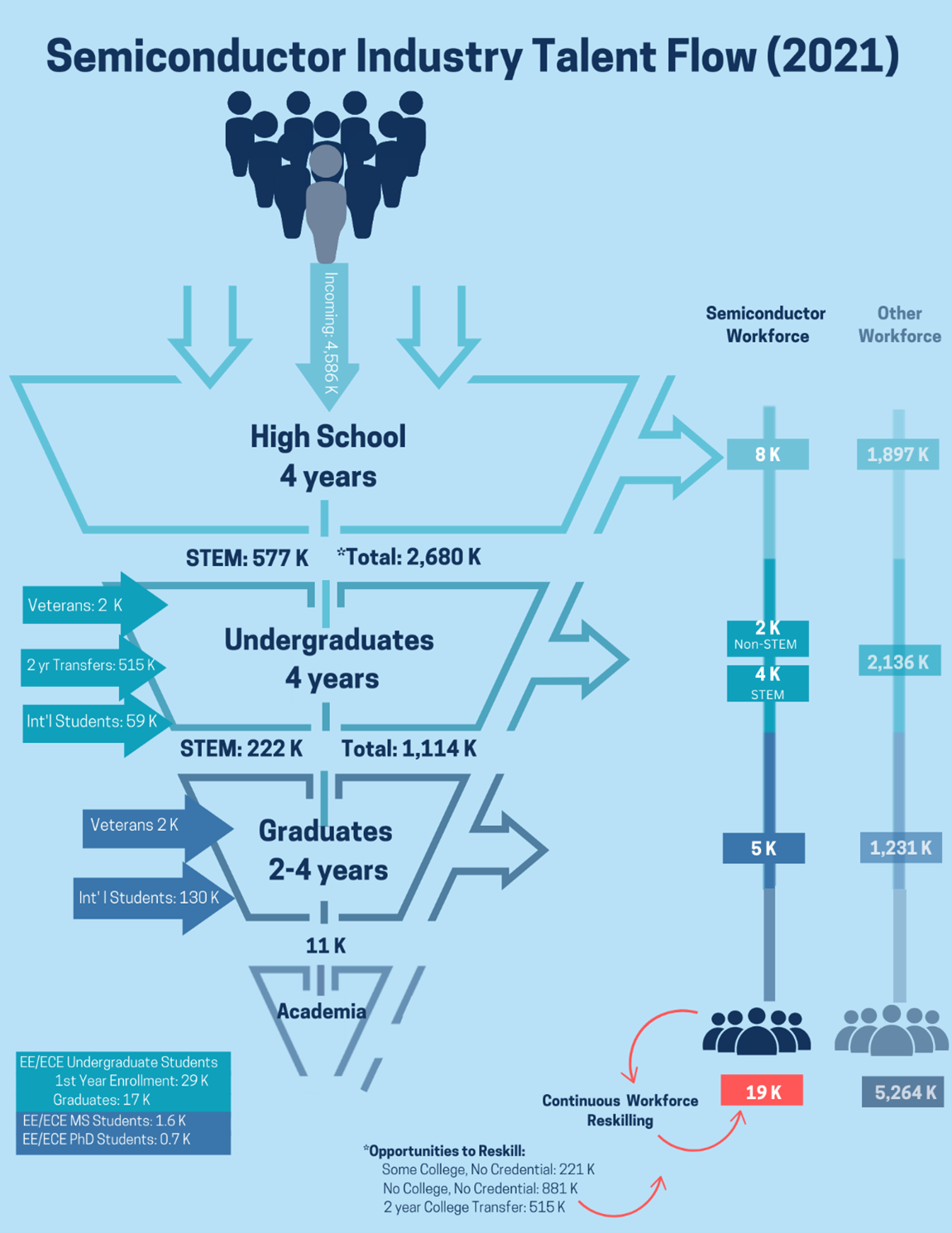Blog 3: Forging Ahead: Aligning Semiconductor Knowledge, Skills and Abilities

Workforce Development Blog
A Talent Factory: The SRC Story
Forging Ahead: Aligning Semiconductor Knowledge, Skills and Abilities
Shaping Tomorrow's Innovators: Strategies for Engaging STEAM Students in the Semiconductor Industry
Entering the Semiconductor Industry: Fulfillment Beyond a Paycheck
Summary of blogs and where do we go from here?
Forging Ahead: Aligning Semiconductor Knowledge, Skills and Abilities
Key points of Blog 3:
- Describes the approach taken by the SRC Microelectronics and Advanced Packaging Technologies (MAPT) Roadmap, which focuses on three specific areas to bridge the talent gap: quantitative supply/demand modeling, effective engagement models, and generating enthusiasm for the industry.
- Emphasize the importance of quantitative supply/demand modeling to understand future talent requirements and strategically allocate resources to meet workforce demands.
- Convey the importance of aligning academic milestones with the required Knowledge, Skills and Abilities (KSAs) for specific job functions within the semiconductor industry, and the need for meaningful industry experiences to establish well-defined career pathways.
At this point, it is widely acknowledged that we face a significant shortage of talent in the semiconductor industry (see Blogs 1 and 2). How can we tackle this issue and where should we begin? Achieving effective workforce development (WFD) requires a collaborative effort as a national community. It is essential to provide access to state-of-the-art educational and training facilities and tools to enable targeted KSA development, experiential learning, and hiring processes.
The SRC MAPT Roadmap (https://srcmapt.org/chapter7/ ) has focused on three specific areas instead of addressing general needs in the semiconductor industry. These three key areas are:
- Quantitative Supply/Demand Modeling: Develop a comprehensive understanding of the industry's future talent requirements. By employing quantitative supply/demand modeling, a timeline can be created to determine when and where employees with specific KSAs will be needed for specific semiconductor jobs. This enables proactive planning and strategic allocation of resources to meet the industry's workforce demands.
- Models for Effective Engagement: Provide students and potential employees with clear career pathways to enter the semiconductor industry and thrive in it. By developing effective engagement models, students and potential employees can be guided toward relevant training and educational and training programs that align with the industry's needs. This approach enhances the likelihood that a diverse group of students will pursue careers in the semiconductor sector, as well as retain and increase the talent pool in the industry.
- Winning Hearts and Minds: Create a favorable perception of the semiconductor industry and generate enthusiasm among individuals across the United States. By showcasing the benefits, opportunities, and advancements available in the field, efforts are made to encourage more people to pursue education and career opportunities in semiconductors. This broader engagement strategy will attract and retain talent, fostering a sustainable pipeline of skilled professionals.
By targeting these three areas, the SRC MAPT Roadmap addresses specific challenges and develops strategies that can effectively bridge the talent gap in the semiconductor industry.
In our previous blog, we committed to focus on the quantitative supply/demand modeling aspect of WFD in the semiconductor industry. Our approach involves an analysis of data to create a comprehensive model that represents the potential talent pool and the required KSAs for the MAPT workforce.
Quantitative Supply/Demand Modeling
We aim to assess data from various sources and consider factors such as company-specific requirements, regional demands, and national trends. By delving into the specifics of each of these aspects, our goal is to develop a highly detailed and granular model that captures the nuances of the industry's talent needs. The model will be available for input in the Supplemental Materials section of the MAPT Roadmap website.
Through this quantitative approach, we can gain a comprehensive understanding of the current and future demand for specific KSAs in the semiconductor industry. This model will enable us to identify areas of talent shortage, anticipate future workforce gaps, and devise proactive strategies to address them effectively.
By leveraging data-driven insights and a granular approach to supply/demand modeling, we will contribute to the development of a robust and responsive workforce in the MAPT sector of the semiconductor industry.
Through an analysis of 2021 data in the graphic below, we have examined the trajectories of prospective talent starting from their entry into high school and continuing through various stages of training, education, and degrees, leading up to their entry into the semiconductor workforce. Our findings reveal a significant disparity in numbers. With over 4.5 million individuals commencing their high school journey each year, ultimately 8,000 directly enter the semiconductor workforce, while 577,000 pursue 4-year STEM degrees in college, while 222,000 pursue advanced degrees. In the end, as little as 19,000 enter the semiconductor industry annually.

Although the current annual intake of 19,000 individuals into the semiconductor industry falls significantly short of our goal of adding 165,000 more skilled workers by 2030, there is reason for optimism. Our analysis has identified potential avenues for reskilling and engaging individuals who can contribute their talents to address the MAPT challenges that lie ahead.
While we acknowledge the considerable gap that needs to be bridged, one tremendous opportunity to inspire and attract more individuals to our industry lies with partially skilled individuals. As the graphic indicates, within the pool of ~2.7 million are people who either possess some college experience but lack credentials; have no college education or credentials; or are 2-year college transfers (221,000; 881,000; and 515,000; respectively).
By implementing initiatives specifically designed to reskill and upskill these individuals, we can tap into their existing talents and enhance their capabilities. Providing targeted support for this untapped talent pool, such as training programs, mentorship opportunities, and career pathways, can significantly increase the number of individuals who are willing and able to lend their expertise to the semiconductor sector.
SRC KSA Matrix for Semiconductor Industry
Knowledge, Skills, and Abilities (KSAs) encompass the qualifications necessary for individuals to effectively fulfill specific roles and carry out designated tasks. Within the semiconductor value chain, a range of both technical and non-technical core competencies are essential to meet the requirements of these roles.
To address this, the SRC MAPT WFD team comprising workforce development experts across the semiconductor ecosystem of design/EDA and manufacturing (IP, fabless, IDM, and foundries), academics, government and non-profit organizations, and industry consultants has developed the SRC KSA Matrix map (see figure below) that correlates broad job functions with the corresponding KSAs needed to perform those specific functions. The demand for workforce to address the grand challenges for growth in information and communication technologies (ICT) described in the SRC Decadal Plan was considered while compiling the KSA. This mapping accessed a wide range of knowledge and skills identified by experts which was partitioned into distinct groupings using a K-means clustering.
As seen below, the KSA Matrix maps skills to specific job functions and ranks the importance as either average, desired, or critical. This is juxtaposed with the relevance of the specific skill to the corresponding job, also shown in the KSA Matrix, to provide a comprehensive understanding of the specific KSAs required within the semiconductor industry. This KSA Matrix framework will be used to create workforce development programs that align with the semiconductor industry's needs to address the challenges identified in chapter 7 of SRC’s MAPT roadmap https://srcmapt.org/chapter7/. The detailed inputs of the blue and orange parameters in the chart below that underly the KSA Matrix can be found in the Supplemental Materials section of the MAPT Roadmap website. We realize that the semiconductor workforce landscape is dynamic, and it is an fundamental prerequisite to periodically update the KSA Matrix with newer skills that become relevant to industry needs in the next 10 – 15 years. KSA Matrix supporting data found in supplemental materials is used to collect feedback from interested stakeholders in WFD activities for the continual process of mapping skills to job needs. Indeed, technological advances especially in the field of AI means that the nature of human work itself is evolving and this will be reflected in future KSA iterations.

We assert that academic milestones should align with the KSAs required for specific job functions in the semiconductor industry. By ensuring that curricula, internships, apprenticeships, and employment opportunities adhere to consistent KSA-based metrics, we can systematically cultivate talent pools that directly match job opportunities.
Nonetheless, we acknowledge that constructing a robust KSA portfolio is just a first step. To foster comprehensive development, it is imperative to offer meaningful internships and other industry experiences that forge strong connections with MAPT companies. These experiences serve as pivotal stepping stones toward establishing well-defined career pathways for aspiring professionals in the semiconductor field.
[Click to download a list of sources used to compile the semiconductor industry talent flow graphic.]
Final Thoughts
Addressing the talent shortage in the semiconductor industry requires a strategic and collaborative approach. Focusing on the three key areas of the SRC MAPT Roadmap (quantitative supply/demand modeling, effective engagement, and winning hearts and minds) will bridge the talent gap effectively.
Continuing to build out the supply/demand model as well as updating the KSA Matrix will emphasize data-driven insights to help identify talent shortage areas. It also helps explore opportunities for reskilling and engaging untapped talent pools to address workforce gaps. The KSA Matrix aligns job functions with specific KSAs, facilitating workforce development programs. Academic alignment with KSAs and meaningful industry experiences are vital for comprehensive talent development.
By implementing these strategies, we can nurture semiconductor knowledge, skills, and abilities, and cultivate a robust and responsive workforce for the MAPT sector and bridge the talent gap in the semiconductor industry.
Have a comment or a question for us? Send it HERE.


